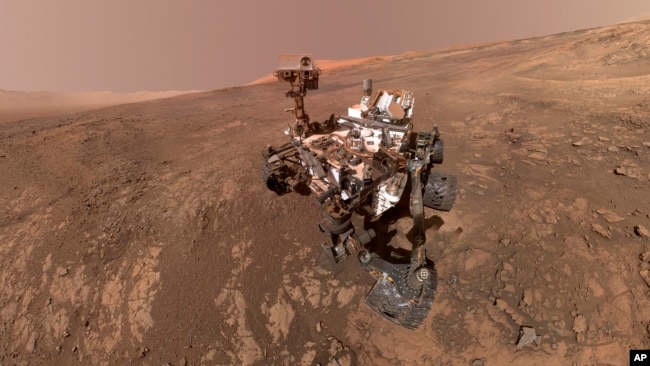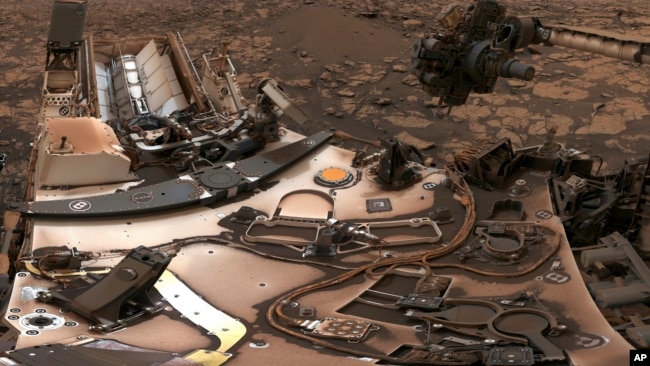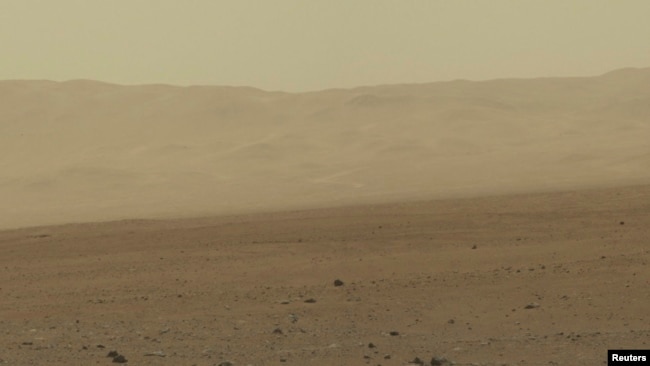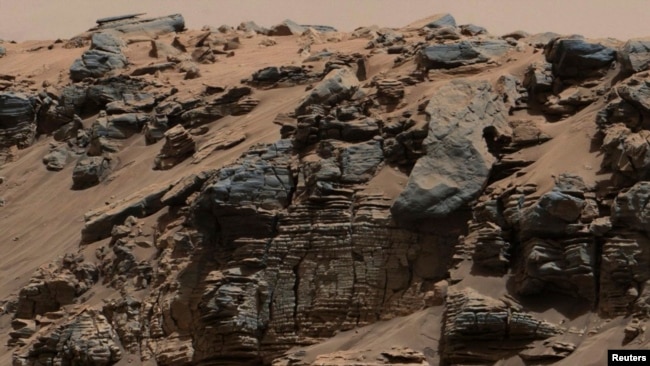Millions of people around the world are currently working from home in an effort to slow the spread of the new coronavirus. Many of them have had to learn new ways of performing their jobs while attempting to turn living spaces into work-friendly environments.
While such change can be difficult for any worker, it can be even harder for a scientist or engineer who cannot work in their usual laboratory setting.
The American space agency NASA employs a large number of these workers. Almost all of them have been working from home for the past month.
Recently, the NASA team that controls the Curiosity explorer on Mars showed that they were able to perform their daily duties completely from their homes. NASA recently reported on the team’s latest activities on its website.

This composite image made from a series of Jan. 23, 2018 photos shows a self-portrait of NASA's Curiosity Mars rover on Vera Rubin Ridge. (NASA/JPL-Caltech/MSSS via AP)
Usually, the Curiosity control team operates from NASA’s Jet Propulsion Laboratory, or JPL, in Pasadena, California. But for the first time ever, all members of the team have had to do all of their work remotely.
Alicia Allbaugh leads the Mars Exploration Program. She said the current situation is very different from the environment her team is used to working in at JPL headquarters. "We're usually all in one room, sharing screens, images and data. People are talking in small groups and to each other from across the room," she said.
The Curiosity team has attempted to recreate the same cooperative work atmosphere by using video conferencing technology and messaging apps. Effective communication is very important. So, team leaders have added extra planning time each day to help make sure all team members are connected.
Carrie Bridge is the chief of science operations for the team. She said one of her main jobs is to be a bridge between the scientists and engineers to make sure they understand each other’s work.

This composite image from Aug. 9, 2018 photos made available by NASA shows the Curiosity rover at Vera Rubin Ridge on Mars. A thin layer of dust is visible on the nuclear-powered rover, the result of a storm that enveloped the planet this summer.
At JPL headquarters, Bridge usually goes around to meet directly with groups working in a “situation room” where Curiosity's data and images are examined and commands are shared. Now, she calls into as many as four separate videoconferences at once.
Bridge said she is also now looking at about 15 different message chats at all times to keep effective communication flowing. "You're juggling more than you normally would," she said.
The remote Curiosity team was lacking some technology and tools they usually use to perform their jobs. Some employees were able to pick up some computer and communications equipment. But other equipment could not be sent home.

FILE - This color image taken August 8, 2012 from NASA's Curiosity rover, and released August 13, shows part of the wall of Gale Crater, the location on Mars where the rover landed on August 5, 2012.
For example, the team uses special goggles, or eyewear, to examine three-dimensional (3D) images sent from Mars. The equipment helps scientists get a better look at the surface of the planet so they know where to drive Curiosity and how far they can extend the explorer’s arm.
The goggles require high-powered computer systems to operate that team members could not set up at home. So, they were told to use simple red-blue 3D glasses instead. While not nearly as sensitive as the usual goggles, the team reported that the low-tech 3D glasses worked just as well for planning drives and arm movements for Curiosity.

Description: An evenly-layered rock on the planet Mars, photographed by the Mast Camera (Mastcam) on NASA's Curiosity Mars Rover is shown in the NASA handout provided December 9, 2014. (REUTERS)
After a lot of planning and test runs, the remote team was excited to announce that the explorer had received its commands from Earth and performed as expected. The first result: Curiosity successfully completed a rock drilling operation in an area called “Edinburgh.”
While the effort required a lot of creative thinking and workflow changes, Carrie Bridge said the experience demonstrated what NASA has always been about. "We're presented with a problem and we figure out how to make things work. Mars isn't standing still for us - we're still exploring."
Words in This Story
remote – adj. far away
screen – n. a flat area on an electronic device where images can be seen
chat – n. an informal talk with someone
juggle – v. to try to do several things at once
three-dimensional – adj. having or seeming to have length, width, and depth
sensitive – adj. able to measure very small details
drill – v. to make holes in hard materials with a machine
workflow – n. the steps involved in moving from the beginning to the end of a working process
figure out – v. to finally understand something or someone after a lot of thought